Falls are a major concern for older people and a key issue for the community.
A study by the Royal Australian College of General Practitioners (RACGP) found 8 per cent of people in their 40s, 14 per cent aged in their 50s, 25 per cent in their 60s, and 40 per cent in their 70s had experienced a fall in the previous 12 months.
It reported that when the falls involved older adults, up to 30 per cent resulted in moderate to severe injuries, such as lacerations, hip fractures and head trauma, and led to an increased risk of early death. Falls may also lead to a fear of falling again, avoidance of daily activities, social isolation and a lowered quality of life.
The study reports that “in the past decade, the falls prevention evidence has expanded and many guidelines now exist. Despite this, there remains a national trend of increasing fall-related hospitalisations, which, if unchanged, will result in escalating healthcare costs.”
What can you do to minimise the risk of a fall?
Falls often occur in the home, where we should feel safe, so it’s vital that we make our homes as fall-proof as possible. Care provider Helping Hands offers the following tips.
Be organised and tidy. The less that is lying around, the less likely you are to trip over anything, so try to keep clutter and mess to a minimum. It is also important to clean up spillages as quickly as possible to avoid slippery floors.
Trip hazards. Check for hazards such as rugs, loose pieces of carpet, uneven floorboards, wires and cables. Repair or remove potentially dangerous items, and run wires and cables around the edge of a room to keep them out of the way. Place electrical appliances as close to the plug socket as possible.
Keep rooms and outdoor areas well lit. Fit good lights all around and outside the house so that you can easily see where you are walking. Consider keeping lights on in hallways and bathrooms in case you need to go to the toilet during the night.
Use non-slip materials. Use non-slip mats and rugs around the house, as well as in the bath, porches and anywhere else that might get slippery. Also consider placing non-slip materials under rugs to keep them in place.
Height hazards. Try to keep everything at a height you can easily reach. If you need steps to help you reach something, make sure that they are stable and sturdy. But ensure that all regularly used items are within reach.
Handles and grab-bars. Install handles or grab-bars in places where you need extra support, such as on stairs, in the bath or toilet.
Get rid of sharp corners. This may involve removing sharp corners from furniture or covering them with corner covers from your hardware store.
Level living. Try to live as much as possible on one level. By adding stairs or even individual steps, you increase the risk of a fall.
We can also take simple precautions to fall-proof ourselves.
No socks or tights. Don’t walk around your home in socks or tights as these can be slippery. Try using inside shoes, slippers or socks with grips on the bottom to reduce the risk of slipping.
Don’t wear long clothes. It is very easy to trip over long skirts or trousers that can catch your heel. Try to wear fitted and properly hemmed clothes.
Don’t rush. Falls can often happen when we are rushing somewhere – to answer the phone or the door, for example. Take your time when you are moving around your home. People will understand. When moving from a seated or prone position, also do this slowly to avoid dizziness.
Alarms. Consider wearing a wrist or pendant alarm, in case you have a fall and cannot get up.
Exercise. The stronger and healthier you are, the less likely you are to have a fall and, if you do, the more likely you will not be hurt. Through regular exercise, you can build up your strength and improve your balance.
Diet. Make sure you eat foods that are rich in calcium and vitamin D to keep your bones strong. And eat regularly to ensure your blood sugar level is sufficient to avoid light-headedness.
The risk of falling is a very real one as we get older, and it is important that it is taken seriously. If you are worried about yourself or a loved one, share your concerns with a health professional, friends and family.
Have you noticed changes in your balance as you’ve aged? What have you done to keep yourself as steady as possible?
Ruby Clarkson is a freelance writer who focuses on issues confronting older citizens and families.
If you enjoy our content, don’t keep it to yourself. Share our free eNews with your friends and encourage them to sign up.
Related articles:
Food ingredient linked to dementia
How eating nuts improves sex
The reluctant grandmother
Disclaimer: This article contains general information about health issues and is not advice. For health advice, consult your medical practitioner.

